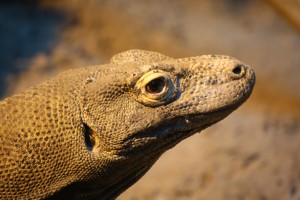FRIDAY, 11 NOVEMBER 2011
Previous studies using engineering techniques had suggested that the lizard’s skull is not adapted for withstanding extreme bite forces, as is typically seen in large carnivores such as tigers. Domenic D’Amore and colleagues from the US, Australia, Chile and France recently tested whether these simulations were accurate by measuring the bite forces generated by the lizards when they bit down on force transducers in an in vivo study.Their results show that although the lizard's bite force is relatively weak for an animal of its size, the amount of force exerted when pulling back against force meters is much larger. This indicates that stripping flesh, rather than biting tissue straight off prey, is a more important strategy for Komodo Dragons.
The researchers highlight that the extent of forces other than merely biting should be considered in order to understand the feeding behaviour of extinct vertebrates.
Written by Nick Crumpton

